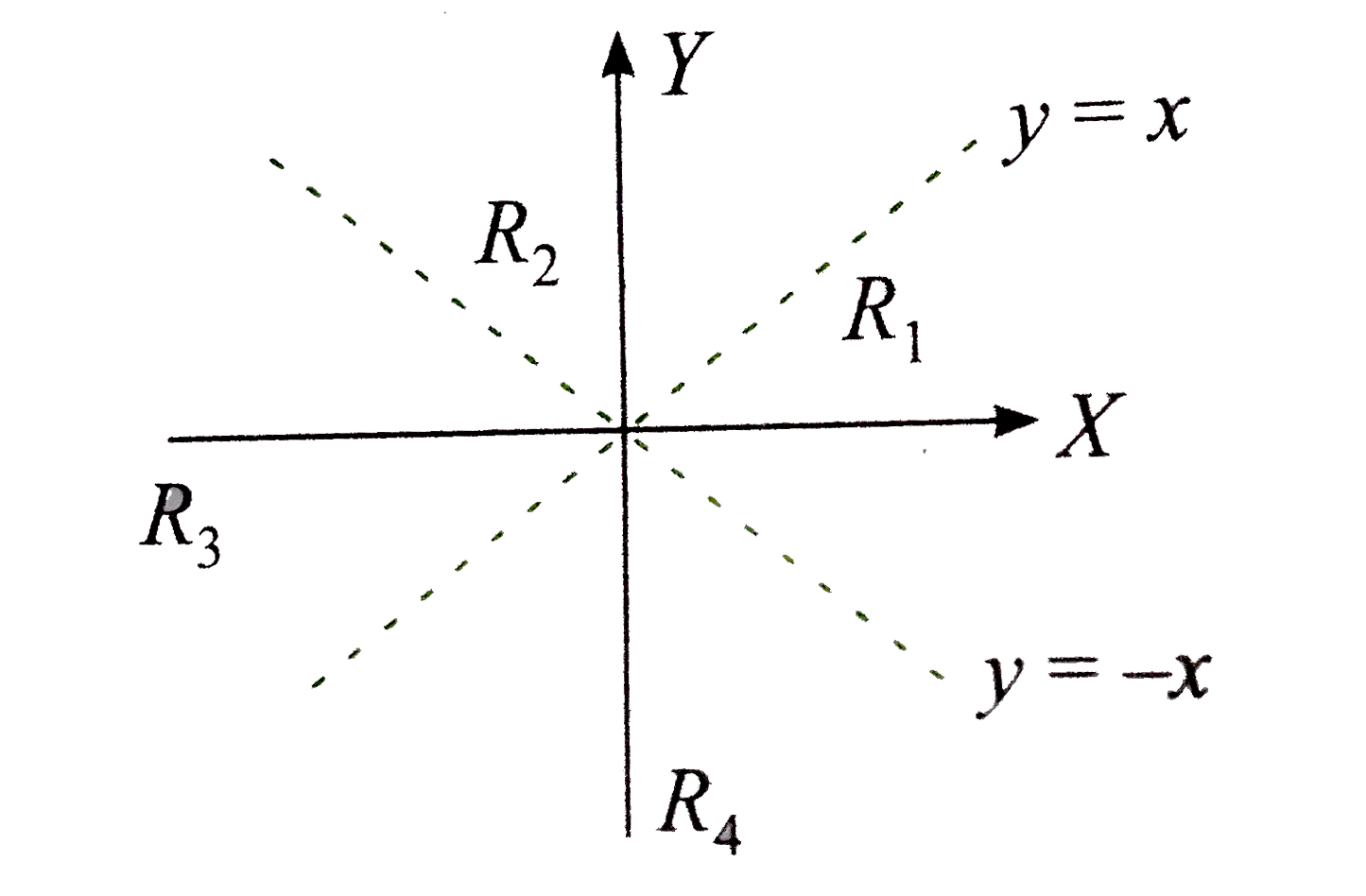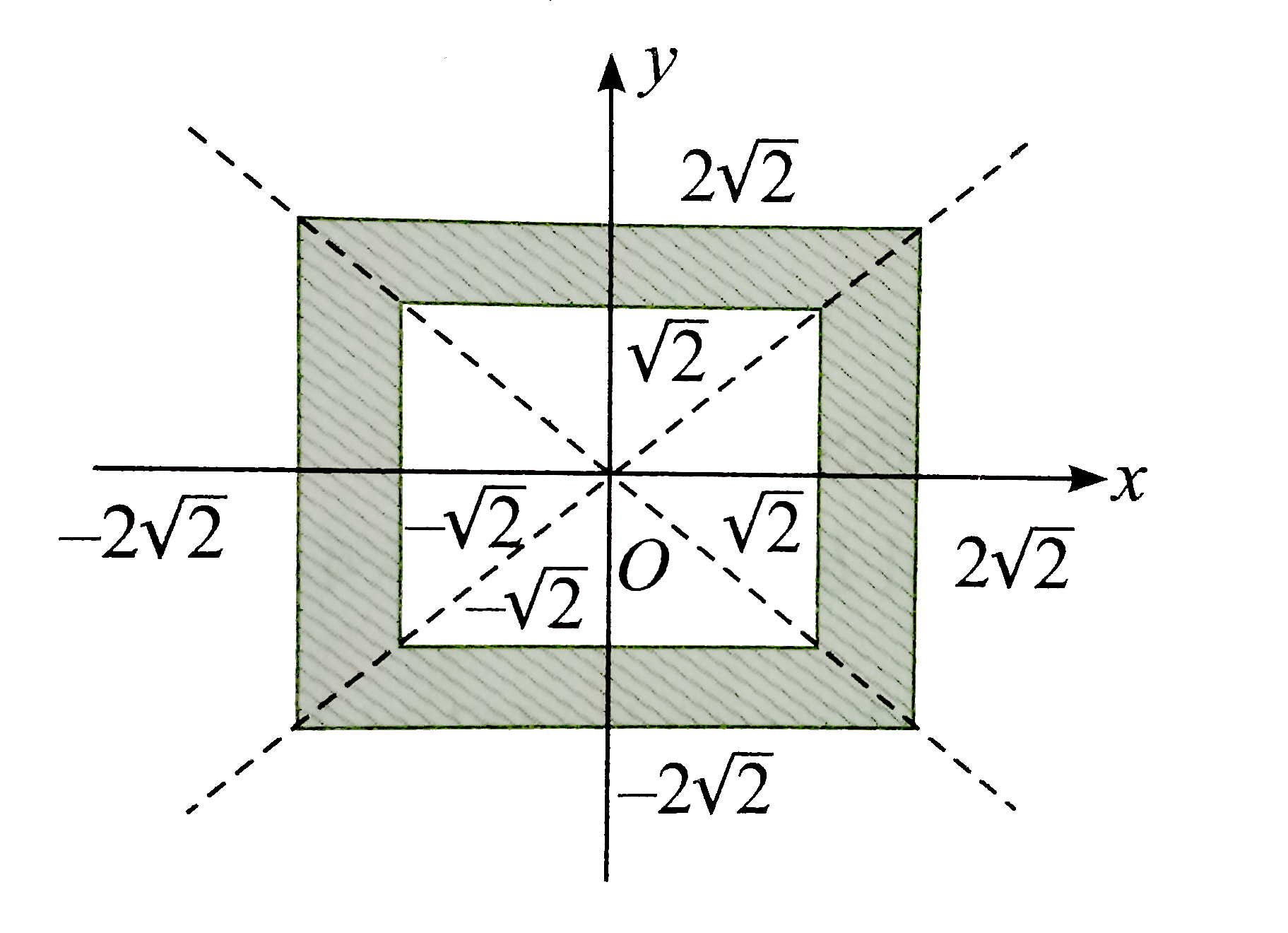Consider two lines L1andL2 given by x−y=0 and x+y=0 , respectively, and a moving point P(x,y). Let d(P,L1),i=1,2, represents the distance of point P from the line Lt If point P moves in a certain region R in such a way that 2≤d(P,P1)+d(P,L1)≤4 , find the area of region R.Solution in Tamil

d(P,L1)=|x−y|√2
and d(P,L2)=|x+y|√2
Now, we have
2≤d(P,L1)+d(P,L2)≤4
or 2√2≤|x−y|+|x+y|≤4√2 (1)
Now, let us consider the four regions, namely, R1,R2,R3 and R4, in the lines L1 and L2 dividing the coordinate plane.
InR1, we have y<x,y>−x.In R2, we have y>x,y>−x.Similarly,
InR3, we have y>x,y<−x.Finally, in R4, we have y<x,y<−x.
Thus , for R2, (1) becomes.
2√2≤x−y+x+y≤4√2 or√2≤x≤2√2
Similarly, for R2, (1) becomes
2√2≤y−x+x+y≤4√2 or√2≤y≤2√2
In R3 ,(1) will become
2√2≤y−x−x−y≤4√2 or−√2≤x≤−2√2
Finally, in R4, (1) will become
2√2≤x−y−x−y≤4√2
or −2√2≤y≤−2√2
Thus region R will be the region between concentric squares formed by the lines x=±√2,y=±√2 and x=±2√2,y=±2√2.
Thus the required are is (4√2)2−(2√2)2=24 units.

Topper's Solved these Questions
- STRAIGHT LINESBOOK - CENGAGECHAPTER - STRAIGHT LINESEXERCISE - Exercise 2.1
23 Videos
- STRAIGHT LINESBOOK - CENGAGECHAPTER - STRAIGHT LINESEXERCISE - Exercise 2.2
4 Videos
- STRAIGHT LINEBOOK - CENGAGECHAPTER - STRAIGHT LINEEXERCISE - Multiple Correct Answers Type
8 Videos
- THEORY OF EQUATIONSBOOK - CENGAGECHAPTER - THEORY OF EQUATIONSEXERCISE - JEE Advanced Previous Year
9 Videos
Similar Questions
Find the equation of the right bisector of the line segment joining the points (3,4) and (−1,2).
View SolutionFind the points on the line x + y = 1 that lie at a distance 3 units from the line 5x+12y = 3.
View SolutionThe point P(α,α+1) will lie inside the triangle whose vertices are A(0,3),B(−2,0) and C(6,1) if
View SolutionQ. Let p and q real number such that p≠0,p2≠q and p2≠−q. if α and β are non-zero complex number satisfying α+β=−p and α3+β3=q, then a quadratic equation having αβ and βα as its roots is
View SolutionFor a point P in the plane, let d1 (P) and d2 (P) be the distance of the point P from the lines x – y = 0 and x + y = 0 respectively. The area of the region R consisting of all points P lying in the first quadrant of the plane and satisfying 2 < d1(P) + d2 (P)< 4, is
View SolutionConsider two lines L1andL2 given by x−y=0 and x+y=0 , respectively, and a moving point P(x,y). Let d(P,L1),i=1,2, represents the distance of point P from the line Lt If point P moves in a certain region R in such a way that 2≤d(P,P1)+d(P,L1)≤4 , find the area of region R.
View SolutionConsider a rectangle ABCD formed by the points A=(0,0), B= (6, 0), C =(6, 4) and D =(0,4), P (x, y) is a moving interior point of the rectangle, moving in such a way that d (P, AB)le min {d (P, BC), d (P, CD) and d (P, AD)} here d (P, AB), d (P, BC), d (P, CD) and d (P, AD) represent the distance of the point P from the sides AB, BC, CD and AD respectively. Area of the region representing all possible positions of the point P is equal to
View SolutionP is a point on the line x=y. If the distance of P from (1,3) is 10 then x and y coordinates of P are both equal to
View SolutionIf a point P moves such that its distance from the point A(1,1) and the line x+y+2=0 are equal then the locus of P is
View SolutionA point 'p' moves in xy plane in such a way that [x+y+1]=[x], where [.] represents the greatest integer function, and n∈(0,2). Area of the region representing all possible positions of the point 'p' is equal to :
View SolutionA point p(x,y) moves in xy plane in such a way that √2≤|x+y|+|x−y|≤2√2. Area of the region representing all possible positions of the point 'p' is equal to :
View SolutionLet P(x,y) be a moving point in the x-y plane such that [x].[y] = 2, where [.] denotes the greatest inte- ger function, then area of the region containing the points P(x,y) is equal to :
View SolutionIf a point P moves such that its distances from the point A(1,1) and the line x+y+2=0 are equal, then the locus of P is
View SolutionFor a point P in the plane, let d1(P)andd2(P) be the distances of the point P from the lines x−y=0andx+y=0 respectively. The area of the region R consisting of all points P lying in the first quadrant of the plane and satisfying 2≤d1(P)+d2(P)≤4, is
View SolutionConsider two lines L1andL2 given by x−y=0 and x+y=0 , respectively, and a moving point P(x,y). Let d(P,L1),i=1,2, represents the distance of point P from the line Lt If point P moves in a certain region R in such a way that 2≤d(P,L1)+d(P,L2)≤4 , find the area of region R.
View SolutionFor a point P in the plane, let d1(P)andd2(P) be the distances of the point P from the lines x−y=0andx+y=0 respectively. The area of the region R consisting of all points P lying in the first quadrant of the plane and satisfying 2≤d1(P)+d2(P)≤4, is
View Solution
